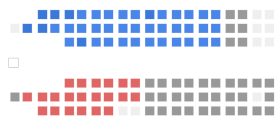Canada Parliament
|
Parliament of Canada Parlement du Canada (French) |
|
|---|---|
| 42nd Canadian Parliament (current) | |
 |
|
| Type | |
| Type | |
| Houses |
Senate House of Commons |
| History | |
| Founded | July 1, 1867 |
| Preceded by |
Initially assumed some jurisdiction from: Later added some jurisdiction from: |
| Leadership | |
|
Elizabeth II
Since 6 February 1952 |
|
|
David Johnston
Since 1 October 2010 |
|
| Structure | |
| Seats |
443 338 MPs 105 Senators |
 |
|
|
Senate political groups
|
Non-affiliated (42)
Conservative (41)
Liberal (21)
Vacant (1)
|
 |
|
|
House of Commons political groups
|
Liberal (182)
Conservative (97)
New Democratic (44)
Bloc Québécois (10)
Green (1)
Independent (1)
Vacant (3)
|
| Elections | |
| Appointment by the governor general on advice of the prime minister | |
| Plurality by constituency | |
|
House of Commons last election
|
19 October 2015 |
| Meeting place | |
 |
|
|
Centre Block Parliament Hill Ottawa, Ontario Canada |
|
| Website | |
| Parliament of Canada | |
Initially assumed some jurisdiction from:
Later added some jurisdiction from:
The Parliament of Canada (French: Parlement du Canada) is the federal legislative branch of Canada, seated at Parliament Hill in the national capital, Ottawa, Ontario. The body consists of the Canadian monarch, represented by a viceroy, the governor general; an upper house: the Senate; and a lower house: the House of Commons. Each element has its own officers and organization. The governor general summons and appoints each of the 105 senators on the advice of the Prime Minister of Canada, while the 338 members of the House of Commons—called members of parliament (MPs)—are directly elected by eligible Canadian voters, with each MP representing a single electoral district, commonly referred to as a riding.
By constitutional convention, the House of Commons is the dominant branch of parliament, the Senate and Crown rarely opposing its will. The Senate reviews legislation from a less partisan standpoint and the monarch or viceroy provides the necessary Royal Assent to make bills into law. The governor general also summons parliament, while either the viceroy or monarch can prorogue or dissolve parliament, the latter in order to call a general election. Either will read the Throne Speech. The most recent parliament, summoned by Governor General David Johnston in 2015, is the 42nd since Confederation in 1867.
...
Wikipedia
